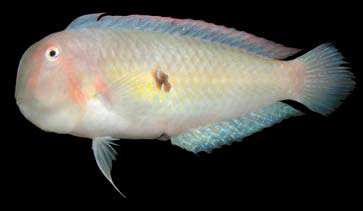| LABRIDAE |

Iniistius bimaculatus, 16.8 cm SL
(photo by Seishi Kimura)
|
Iniistius bimaculatus (Rüppell, 1829) Twospot Razorfish |
|
D IX, 12; A III, 12; P1 12; LLp 19-20 + 4-5; GR 17-22. Body deep, very compressed. Dorsal profile of head strongly convex in front of eye; snout very steep, the anterior edge thin. A pair of slender, long, incurved, and slightly outflaring canine teeth anteriorly in each jaw. Origin of dorsal fin posterior to a vertical at hind edge of eye; first 2 dorsal spines flexible, 2-3 times longer than the third spine; membrane between the second and third spines notched half or more length of the third spine. Caudal fin small, asymmetrically rounded. Color: males pale grey, the scale edges a little darker, with a blackish spot on midside below tip of pectoral fin, spot covers 3 scales in fifth and sixth rows from top of body; a pale yellowish blotch preceding the black spot; a median blue line at front of head; pectoral-fin base white; dorsal fin dusky with a pale oranges thin line along base of soft-rayed portion, and just beneath on back is a thin, of similar length, bluish line; posterior part of dorsal fin with a series of rows of pale oranges spots; anal fin translucent white with a series of yellowish dashes or elongate spots on fin; mid to upper portion of the caudal fin with a series of narrow vertical, irregular oranges stripes. Females lack the black spot on side. Size: maximum length about 20 cm. Distribution: Indo-West Pacific. Remarks: found in areas with sandy bottoms in shallow waters to at least 50 m depth. |
|
|